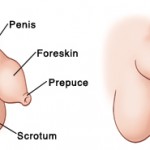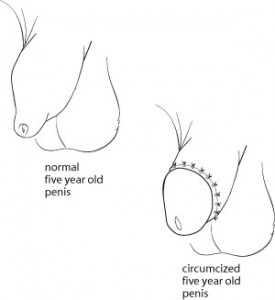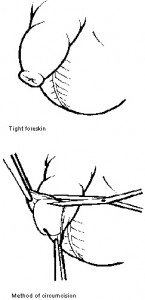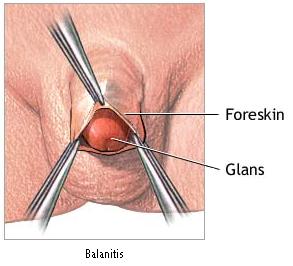Is your little boy having problems in urinating due to his foreskin almost blocking the aperture of his penis? He may be suffering from Phimosis, a common condition in little male children. Read on to know all about Phimosis, its causes, symptoms, diagnosis and treatment.
Phimosis Definition
Page Contents

Picture 1 – Phimosis Picture
Source – causticsodapodcast
Phimosis is a medical condition that is characterized by limited exposure of the glans clitoridis, the red mass of tissue that stands at the tip of the penis. This happens when the foreskin of the penis tightly sits over the aperture of the penis and cannot be retracted. In uncircumcised male infants, the foreskin is normally tight in the initial years and become retractable as the boy begins to grow. But in case of Phimosis in infants, the foreskin is not easily retractable and neither does it loosen with time. This causes problems during urination and if not corrected in time, can hinder sexual activity.
Phimosis Meaning
The term Phimosis comes from the Greek word “phimos” meaning “muzzle” which is an obvious reference to the muzzled or blocked condition of the penis.
Types of Phimosis
Phimosis may either be congenital or acquired.
Congenital Phimosis
In Congenital Phimosis cases, the condition results from defects arising while the child is still in fetus. The disorder is also known as Primary Phimosis.
Acquired Phimosis
In case of Acquired Phimosis, the patient develops a phimosis ring after his birth. The foreskin becomes difficult to stretch. The disease is also called Secondary Phimosis.
Phimosis Symptoms
Some of the main problems associated with Phimosis are :
Pain
The affected child experiences pain at the tip of the penis, especially during urination or ejaculation during sexual activity.
Penile Inflammation
The sufferer also experiences swelling at the head of his penis. The inflammation may aggravate while passing urine. The constricted penile aperture makes urination difficult and the urine builds up inside the penis leading to swelling.
Penile Discharge
In some cases, a discharge may be released from the penis. This may be foul-smelling.
Penile Bleeding
In serious cases, the person may also suffer from bleeding in the penile region.
Cancer
In very rare cases, Phimosis may lead to Penile Cancer.
Phimosis Causes
A lot of factors may give rise to Phimosis. These are :
Congenital Defect
In many sufferers of Phimosis congenital anomaly is held to be the prime causative factor.
Yeast Infection
If Yeast Infection in males is not treated in time, it can also lead to complications like Phimosis. The infection causes swelling in the foreskin and Glans Penis. The Glans Penis and foreskin begin to cling together causing phimosis problems.
In a few cases of Phimosis diabetes is found to result in yeast infection.
Poor Hygiene
Not following proper hygiene can make the genital prone to infections and give rise to swelling in foreskin and other problems leading to Phimosis.
Is Phimosis Genetic?
In some cases, genetic factors can play a role. But Phimosis in kids may or may not arise due to heredity. One may inherit the condition in a few cases. Genetics is not always responsible for the appearance of this disease. Even absolutely normal people can give birth to a male child with Phimosis.
Phimosis Diagnosis
In case of Phimosis doctors normally carry out a diagnosis by physical examination. If there is an infection, a skin biopsy may be carried out.
Phimosis Treatment
Even if the condition does not cause any discomfort or pain, immediate treatment of phimosis is necessary. This is especially important in cases where there is tightening of the foreskin in early years. Treatment includes both non-surgical as well as surgical means.
Phimosis Non-Surgical Treatment
Phimosis treatment without surgery involves topical application of creams. In patients with Phimosis steroid creams are applied over the foreskin and the skin is gently pulled. This helps loosen the foreskin and expose the penis aperture. The treatment can be used for both children and adults. In many sufferers of Phimosis creams like Hydrocortisone have been found quite effective in loosening the skin.
If manual efforts prove unsuccessful, doctors may try balloon inflation of the skin. This can help stretch the foreskin better than topical cream application.
In children over 3 years having Phimosis Betamethastone cream can be a safe mode of treatment. If there is no improvement even after application for a month, surgical methods are needed for Phimosis cure.
Phimosis Surgery

Picture 2 – Phimosis Surgical Treatment
Source – uroinfo
Phimosis does not go away naturally in adults. For treatment of Phimosis operation is often necessary.
In grown up males, treatment is normally done in the form of circumcision. Circumcision is a process that involves removing the upper part of the foreskin by surgical means. The remaining retractable part is left undisturbed. In very painful or inflamed cases of Phimosis, circumcision works as an immediate relief.
In patients with Clitoral Phimosis Hoodectomy Surgery is carried out to remove a small amount of tissue from the penis. This exposes the clitoris thus making urination easier. But it can take away from sexual pleasure as clitoral orgasm becomes impossible after this operation.
Phimosis Natural Treatment
If Phimosis symptoms are seen to arise because of infections, practising good hygiene can be quite effective. Cleaning and washing the genital area with a mild soap and drying the region properly afterwards can cure as well as prevent infection. It is one of the best Phimosis home treatments.
A healthy diet and proper lifestyle can help cure yeast infection, which sometimes leads to Phimosis problems.
Avoiding sexual relations with infected people can also help in faster recovery from the disorder. Yeast infection is contagious and can spread from person to person due to sexual contact.
Avoiding glycerine, harsh soaps and lubricants containing additives may also keep the disease away and work as a Phimosis remedy.
Phimosis Pictures

Picture 3 – Phimosis Stretching
Source – blogspot

Image 4 – Phimosis Surgery
Source – nevdgp
Want to know what does Phimosis look like? Check out these Phimosis images. These Phimosis photos will give you a fair idea about the appearance of the disease.
Phimosis and Paraphimosis
Very complicated cases of Phimosis can result in Paraphimosis. This is characterized by a swollen and painful Glans Penis. It becomes impossible to pull the foreskin. The rear part of the penis becomes flaccid. It is a serious situation that needs immediate medical treatment.
Phimosis Complications
Chronic problems of acquired Phimosis can lead to discomfort and pain during sexual intercourse and even urination. The urine fails to find a proper release with the blockage of the penis aperture. Urine falls in drops and the penis swells. Urination becomes extremely painful. In very serious cases, urination may stop altogether. This can be life-threatening for the sufferer and an immediate medical treatment is necessary. With early treatment of Phimosis recovery is also faster.
If you have cases of Phimosis in children or adults in your family, or are suffering from it yourself, it is advisable that you begin treatment at the earliest. Early treatment will help you enjoy lead a better life, free from all discomforts, and avoid all possible health complications in future.


No Responses